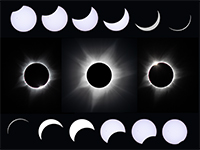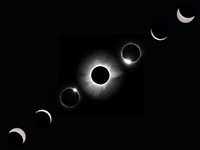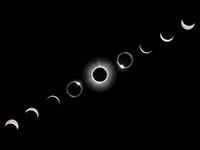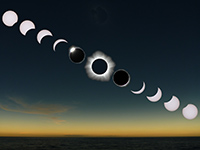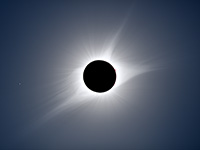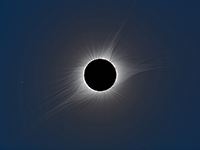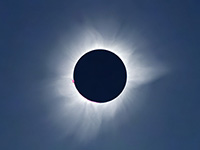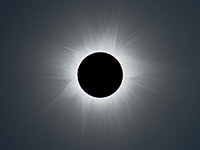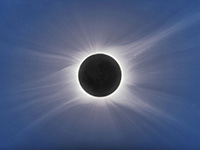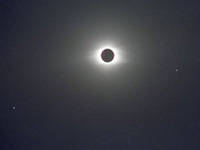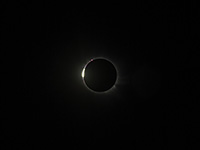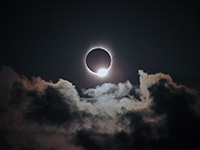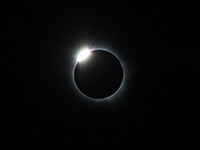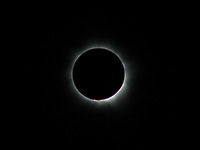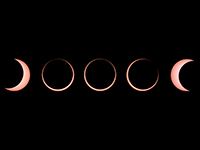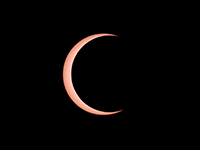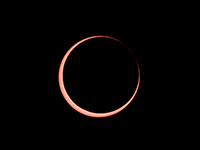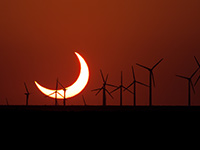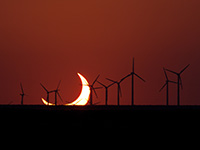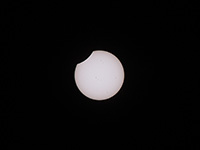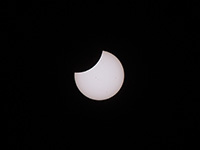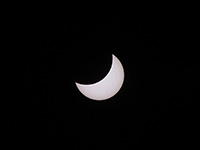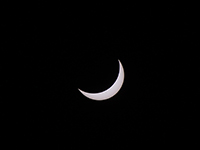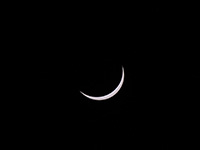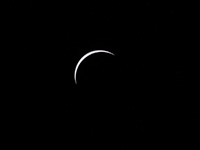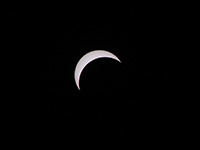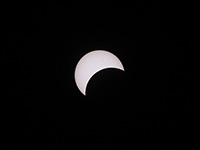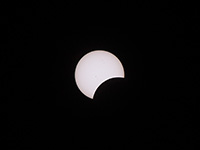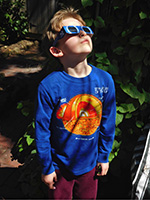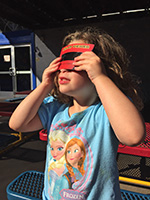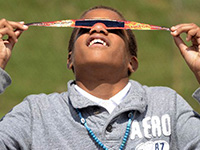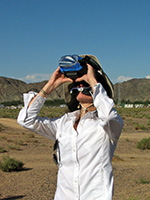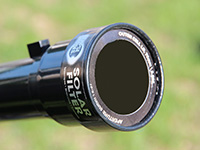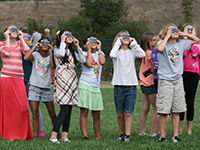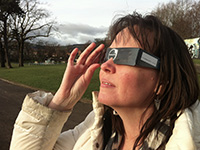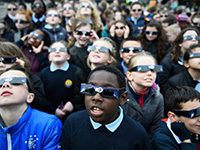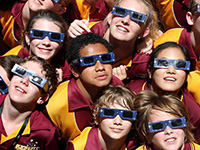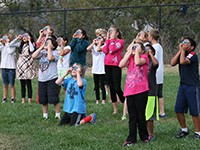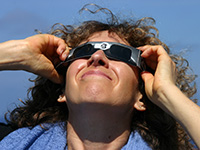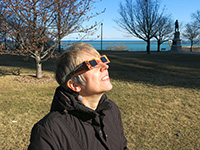
Here you'll find an assortment of images and videos of solar eclipses and people experiencing them. These resources kindly have been provided by their owners, who retain copyright, mainly to help educators and journalists who need eclipse-related graphics for their lessons and media reports, respectively, though anyone may use them subject to the following terms. ![]() These images and videos are offered with a Creative Commons Attribution-NonCommercial-NoDerivatives 4.0 International License. This means that if you use any of them you must give appropriate credit to the photographer/videographer. Furthermore, you may not use any of these resources for commercial purposes, and if you change, remix, transform, or build upon an image or video, you may not distribute the modified material. If you have an image or video that you would like to make available here for others to use on these terms, please contact us; we can't guarantee that we'll add the item to our website, but we will consider it.
These images and videos are offered with a Creative Commons Attribution-NonCommercial-NoDerivatives 4.0 International License. This means that if you use any of them you must give appropriate credit to the photographer/videographer. Furthermore, you may not use any of these resources for commercial purposes, and if you change, remix, transform, or build upon an image or video, you may not distribute the modified material. If you have an image or video that you would like to make available here for others to use on these terms, please contact us; we can't guarantee that we'll add the item to our website, but we will consider it.
- AAS Video: Introduction to Solar Eclipse Safety
- Sequences of Total Solar Eclipses from Start to Finish
- Photos of the Solar Corona During Totality
- Photos of Phenomena at the Beginning or End of Totality
- Photos of an Annular Solar Eclipse
- Photos of the Partial Phases of a Solar Eclipse
- Photos of Safe Solar Filters & People Using Them
- Miscellaneous Photos & Videos
- Other Sources of Royalty-free Photos & Videos
Click on the thumbnail images to download bigger, higher-resolution images or videos.
AAS Video: Introduction to Solar Eclipse Safety
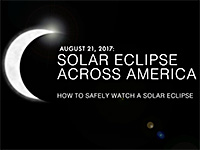 MP4 video (running time 4m 27s) explaining that it's safe to look directly at the totally eclipsed Sun and highlighting some of the ways to safely view the uneclipsed or partially eclipsed Sun. This video was created for the August 2017 solar eclipse, but the advice if offers is relevant to the 2023 and 2024 North American eclipses too. Credit: American Astronomical Society
MP4 video (running time 4m 27s) explaining that it's safe to look directly at the totally eclipsed Sun and highlighting some of the ways to safely view the uneclipsed or partially eclipsed Sun. This video was created for the August 2017 solar eclipse, but the advice if offers is relevant to the 2023 and 2024 North American eclipses too. Credit: American Astronomical Society
Sequences of Total Solar Eclipses from Start to Finish (or Nearly So)
The total solar eclipse of April 20, 2023, as seen from a cruise ship anchored in Exmouth Bay, Australia. The top row shows the partial phases before totality, which lasted about 1¼ hours. The middle row shows the ~1 minute of totality from the first diamond ring to the second. The bottom row shows the partial phases after totality, which again lasted about 1¼ hours. Each row should be read from right to left; the Moon (seen here in silhouette) moved down and to the right during the eclipse. During the partial phases before and after totality, the camera lens was covered by a safe solar filter. No filter was used during totality, which is about as bright as the full Moon and just as safe to look at. Credit: Michael Zelier / GreatAmericanEclipse.com
The total solar eclipse of March 9, 2016, as seen from aboard the cruise ship Le Soleál in the Molucca Sea off the coast of Indonesia. This sequence runs from upper right to lower left. During the partial phases before and after totality, the camera lens was covered by a safe solar filter. No filter was used during totality, which is about as bright as the full Moon and just as safe to look at. Credit: Rick Fienberg / TravelQuest International / Wilderness Travel
The total solar eclipse of November 3, 2013, as seen from aboard the cruise ship Corinthian off the west coast of Africa near Sierra Leone. This sequence runs from upper right to lower left. During the partial phases before and after totality, the camera lens was covered by a safe solar filter. No filter was used during totality, which is about as bright as the full Moon and just as safe to look at. Credit: Rick Fienberg / TravelQuest International / Wilderness Travel
The total solar eclipse of November 14, 2012, as seen from aboard the cruise ship Paul Gauguin in the South Pacific near New Caledonia. This sequence runs from lower right to upper left. During the partial phases before and after totality, the camera lens was covered by a safe solar filter. No filter was used during totality, which is about as bright as the full Moon and just as safe to look at. The background is an unfiltered, wide-field view of the ocean and sky during totality, showing sunrise/sunset colors along the horizon. Credit: Rick Fienberg / TravelQuest International / Wilderness Travel
Photos of the Solar Corona During Totality
The total phase of the August 21, 2017, solar eclipse as seen from Madras, Oregon. This is a composite of short, medium, and long exposures, as no single exposure can capture the huge range of brightness exhibited by the solar corona. The star to the left (east) of the eclipsed Sun is Regulus, the brightest star in the constellation Leo. Much fainter Nu (ν) Leonis is visible at upper right. No filter was used during the exposures, as totality is about as bright as the full Moon and just as safe to look at. At all other times, though, a safe solar filter is required to observe or photograph the Sun. Credit: Rick Fienberg / TravelQuest International
Same as above, but with additional processing by Sean Walker of Sky & Telescope to enhance the visibility of fine details in the corona. Credit: Rick Fienberg / TravelQuest International / Sean Walker / Sky & Telescope
The total phase of the March 9, 2016, solar eclipse as seen from aboard the cruise ship Le Soleál in the Molucca Sea off the coast of Indonesia. This is a composite of short, medium, and long exposures, as no single exposure can capture the huge range of brightness exhibited by the solar corona. No filter was used during the exposures, as totality is about as bright as the full Moon and just as safe to look at. At all other times, though, a safe solar filter is required to observe or photograph the Sun. Credit: Rick Fienberg / TravelQuest International / Wilderness Travel
The total phase of the March 20, 2015, solar eclipse as seen from the Svalbard archipelago in the Arctic. This is a composite of short, medium, and long exposures, as no single exposure can capture the huge range of brightness exhibited by the solar corona. The longest exposure in the composite captured the faint illumination of the Moon by earthshine, that is, sunlight reflected off the Earth. No filter was used during the exposures, as totality is about as bright as the full Moon and just as safe to look at. At all other times, though, a safe solar filter is required to observe or photograph the Sun. Credit: Reinhard Wittich
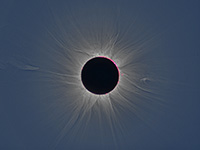 The total phase of the November 3, 2013, solar eclipse as seen from Gabon, Africa. This is a composite of short, medium, and long exposures, as no single exposure can capture the huge range of brightness exhibited by the solar corona. No filter was used during the exposures, as totality is about as bright as the full Moon and just as safe to look at. At all other times, though, a safe solar filter is required to observe or photograph the Sun. Credit: Jay Pasachoff / Allen Davis / Vojtech Rusin / Miloslav Druckmüller
The total phase of the November 3, 2013, solar eclipse as seen from Gabon, Africa. This is a composite of short, medium, and long exposures, as no single exposure can capture the huge range of brightness exhibited by the solar corona. No filter was used during the exposures, as totality is about as bright as the full Moon and just as safe to look at. At all other times, though, a safe solar filter is required to observe or photograph the Sun. Credit: Jay Pasachoff / Allen Davis / Vojtech Rusin / Miloslav Druckmüller
The total phase of the November 13, 2012, solar eclipse as seen from Australia. This is a composite of short, medium, and long exposures, as no single exposure can capture the huge range of brightness exhibited by the solar corona. No filter was used during the exposures, as totality is about as bright as the full Moon and just as safe to look at. At all other times, though, a safe solar filter is required to observe or photograph the Sun. Credit: Robert B. Slobins
Totality as seen from Easter Island on July 11, 2010. This is a composite of short, medium, and long exposures, as no single exposure can capture the huge range of brightness exhibited by the solar corona. No filter was used during the exposures, as totality is about as bright as the full Moon and just as safe to look at. At all other times, though, a safe solar filter is required to observe or photograph the Sun. Credit: Dennis di Cicco / Sky & Telescope
Totality as seen from Aruba on February 26, 1998. The dots to lower left and right of the eclipsed Sun are the planets Mercury and Jupiter, respectively. On August 21, 2017, Mercury and Mars will be similarly close to the Sun during totality, though considerably fainter and harder to see. Jupiter and Venus will be much brighter but also much farther out, such that you'll have to look away from the Sun to spot them. No filter was used during this exposure, as totality is about as bright as the full Moon and just as safe to look at. At all other times, though, a safe solar filter is required to observe or photograph the Sun. Credit: Robert B. Slobins
Photos of Phenomena at the Beginning or End of Totality
Right before totality begins, the only parts of the Sun's bright face not yet covered by the Moon are those that peek through deep valley's on the advancing lunar limb (edge). Seen through safe solar filters, they look like an arc of bright points. These are called Baily's Beads, after English astronomer Francis Baily, who first described them during a solar eclipse in 1836. They disappear one after another as the Moon continues its advance. Their subsequent reappearance, as the Moon begins its retreat, signals the end of totality. Also visible at the beginning and end of totality are brilliant red arcs, loops, and jets of hot gas. Called prominences, they originate in the chromosphere — the thin middle layer of the Sun's atmosphere — and shine in the ruby-red light of hydrogen heated to more than 20,000° Celsius (36,000° Fahrenheit). Credit: Reinhold Wittich
Right before totality begins, the only parts of the Sun's bright face not yet covered by the Moon are those that peek through deep valley's on the advancing lunar limb (edge). Seen through safe solar filters, they look like an arc of bright points. These are called Baily's Beads, after English astronomer Francis Baily, who first described them during a solar eclipse in 1836. They disappear one after another as the Moon continues its advance. Their subsequent reappearance, as the Moon begins its retreat, signals the end of totality. Also visible at the beginning and end of totality are brilliant red arcs, loops, and jets of hot gas. Called prominences, they originate in the chromosphere — the thin middle layer of the Sun's atmosphere — and shine in the ruby-red light of hydrogen heated to more than 20,000° Celsius (36,000° Fahrenheit). Credit: Robert B. Slobins
One of the most beautiful sights associated with a total solar eclipse is the "diamond ring." It appears just before the beginning of totality, when a single bright point of sunlight — the diamond — shines through a deep valley on the Moon's limb (edge) and the inner corona — the ring — becomes visible. As the diamond vanishes, it's safe to remove your solar filters. A second diamond ring appears at the end of totality when a deep valley on the opposite side of the retreating Moon exposes a single bead of bright sunlight that begins to wash out the corona. Put your filters back on! Credit: Rick Fienberg / TravelQuest International / Wilderness Travel
One of the most beautiful sights associated with a total solar eclipse is the "diamond ring." It appears just before the beginning of totality, when a single bright point of sunlight — the diamond — shines through a deep valley on the Moon's limb (edge) and the inner corona — the ring — becomes visible. As the diamond vanishes, it's safe to remove your solar filters. A second diamond ring appears at the end of totality when a deep valley on the opposite side of the retreating Moon exposes a single bead of bright sunlight that begins to wash out the corona. Put your filters back on! Credit: Reinhold Wittich
One of the most beautiful sights associated with a total solar eclipse is the "diamond ring." It appears just before the beginning of totality, when a single bright point of sunlight — the diamond — shines through a deep valley on the Moon's limb (edge) and the inner corona — the ring — becomes visible. As the diamond vanishes, it's safe to remove your solar filters. A second diamond ring appears at the end of totality when a deep valley on the opposite side of the retreating Moon exposes a single bead of bright sunlight that begins to wash out the corona. Put your filters back on! Credit: Rick Fienberg / TravelQuest International / Wilderness Travel
The beginning and end of totality present your best opportunities to examine the thin middle layer of the Sun's atmosphere, called the chromosphere. It shines in the ruby-red light of hydrogen gas heated to more than 20,000° Celsius (36,000° Fahrenheit). Also visible just beyond the Moon's silhouette are solar prominences: brilliant red arcs, loops, and jets of hot gas propelled by the explosive release of the Sun's magnetic energy. Credit: Rick Fienberg / TravelQuest International / Wilderness Travel
The beginning and end of totality present your best opportunities to examine the thin middle layer of the Sun's atmosphere, called the chromosphere. It shines in the ruby-red light of hydrogen gas heated to more than 20,000° Celsius (36,000° Fahrenheit). Also visible just beyond the Moon's silhouette are solar prominences: brilliant red arcs, loops, and jets of hot gas propelled by the explosive release of the Sun's magnetic energy. During totality, with the Moon covering all of the Sun's brilliant face, it is perfectly OK to look at the spectacle without solar filters — indeed, if you try to observe totality through solar filters, you won't see anything at all! Binoculars will show the chromosphere and prominences especially well. Credit: Robert B. Slobins
Photos of an Annular ("Ring") Solar Eclipse
On May 10, 1994, an annular eclipse swept across the U.S. from the desert Southwest to New England. This sequence from shortly before annularity to shortly afterward was captured from Ogunquit, Maine, through a telescope with a safe solar filter covering its front lens. The sequence runs from right to left; that is, the Moon moved across the Sun from right to left. The photographer was situated somewhat south of the eclipse's centerline, so the Moon passed slightly north of the center of the Sun's disk. Credit: Rick Fienberg / Sky & Telescope
On May 10, 1994, an annular eclipse swept across the U.S. from the desert Southwest to New England. This photo was taken a few minutes before the Moon moved directly in front of the Sun. It was captured from Ogunquit, Maine, through a telescope with a safe solar filter covering its front lens. Credit: Rick Fienberg / Sky & Telescope
On May 10, 1994, an annular eclipse swept across the U.S. from the desert Southwest to New England. This photo was taken a few seconds before the Moon moved directly in front of the Sun. It was captured from Ogunquit, Maine, through a telescope with a safe solar filter covering its front lens. Note the broken arc of sunlight at upper right, caused by mountains and valley's on the Moon's limb (edge). Credit: Rick Fienberg / Sky & Telescope
On May 10, 1994, an annular eclipse swept across the U.S. from the desert Southwest to New England. This photo was taken while the Moon was situated directly between Earth and the Sun. Because the Moon was farther away than average and the Sun was closer than average, the Moon's disk didn't fully cover the Sun's, creating a "ring of fire" around the Moon's dark silhouette. The photo was captured from Ogunquit, Maine, through a telescope with a safe solar filter covering its front lens. Credit: Rick Fienberg / Sky & Telescope
Photos of the Partial Phases of a Solar Eclipse
On May 20, 2012, the Sun set while in deep partial eclipse as seen from the U.S. Southwest. This scene was captured from the San Juan Mesa Wind Farm off Highway 70 in Elinda, New Mexico. Credit: Evan Zucker
On May 20, 2012, the Sun set while in deep partial eclipse as seen from the U.S. Southwest. This scene was captured from the San Juan Mesa Wind Farm off Highway 70 in Elinda, New Mexico. Credit: Evan Zucker
The partially eclipsed Sun, photographed through a telephoto lens capped with a special-purpose solar filter. The Moon covers 10% of the Sun's diameter and not quite 2% of its area. Dark sunspots speckle the solar disk. Credit: Rick Fienberg / TravelQuest International / Wilderness Travel
The partially eclipsed Sun, photographed through a telephoto lens capped with a special-purpose solar filter. The Moon covers 30% of the Sun's diameter and about 19% of its area. Dark sunspots speckle the solar disk. Credit: Rick Fienberg / TravelQuest International / Wilderness Travel
The partially eclipsed Sun, photographed through a telephoto lens capped with a special-purpose solar filter. The Moon covers 61% of the Sun's diameter and about 52% of its area. Dark sunspots speckle the solar crescent. Credit: Rick Fienberg / TravelQuest International / Wilderness Travel
The partially eclipsed Sun, photographed through a telephoto lens capped with a special-purpose solar filter. The Moon covers 83% of the Sun's diameter and about 79% of its area. Dark sunspots speckle the solar crescent. Credit: Rick Fienberg / TravelQuest International / Wilderness Travel
The partially eclipsed Sun, photographed through a telephoto lens capped with a special-purpose solar filter. The Moon covers 93% of the Sun's diameter and about 91% of its area. Credit: Rick Fienberg / TravelQuest International / Wilderness Travel
The partially eclipsed Sun, photographed through a telephoto lens capped with a special-purpose solar filter. The Moon covers 95% of the Sun's diameter and about 94% of its area. Credit: Rick Fienberg / TravelQuest International / Wilderness Travel
The partially eclipsed Sun, photographed through a telephoto lens capped with a special-purpose solar filter. The Moon covers 83% of the Sun's diameter and about 79% of its area. Credit: Rick Fienberg / TravelQuest International / Wilderness Travel
The partially eclipsed Sun, photographed through a telephoto lens capped with a special-purpose solar filter. The Moon covers 71% of the Sun's diameter and about 64% of its area. Dark sunspots speckle the solar crescent. Credit: Rick Fienberg / TravelQuest International / Wilderness Travel
The partially eclipsed Sun, photographed through a telephoto lens capped with a special-purpose solar filter. The Moon covers 58% of the Sun's diameter and about 49% of its area. Dark sunspots speckle the solar crescent. Credit: Rick Fienberg / TravelQuest International / Wilderness Travel
The partially eclipsed Sun, photographed through a telephoto lens capped with a special-purpose solar filter. The Moon covers 35% of the Sun's diameter and about 23% of its area. Dark sunspots speckle the solar disk. Credit: Rick Fienberg / TravelQuest International / Wilderness Travel
The partially eclipsed Sun, photographed through a telephoto lens capped with a special-purpose solar filter. The Moon covers 7% of the Sun's diameter and about 2% of its area. Dark sunspots speckle the solar disk. Credit: Rick Fienberg / TravelQuest International / Wilderness Travel
Photos of Safe Solar Filters & People Using Them
A total solar eclipse is about as bright as the full Moon — and just as safe to look at. But the Sun at any other time is dangerously bright; view it only through special-purpose “eclipse glasses” or hand-held solar viewers that meet the ISO 12312-2 international standard for such products. Homemade filters or ordinary sunglasses, even very dark ones, are not safe for looking at the uneclipsed or partially eclipsed Sun. Credit: Jay M. Pasachoff
A total solar eclipse is about as bright as the full Moon — and just as safe to look at. But the Sun at any other time is dangerously bright; view it only through special-purpose “eclipse glasses” or hand-held solar viewers that meet the ISO 12312-2 international standard for such products. Homemade filters or ordinary sunglasses, even very dark ones, are not safe for looking at the uneclipsed or partially eclipsed Sun. Credit: Jay M. Pasachoff
A total solar eclipse is about as bright as the full Moon — and just as safe to look at. But the Sun at any other time is dangerously bright; view it only through special-purpose “eclipse glasses” or hand-held solar viewers that meet the ISO 12312-2 international standard for such products. Homemade filters or ordinary sunglasses, even very dark ones, are not safe for looking at the uneclipsed or partially eclipsed Sun. Credit: Charlie Bates, courtesy Mark Margolis / Rainbow Symphony
A total solar eclipse is about as bright as the full Moon — and just as safe to look at. But the Sun at any other time is dangerously bright; view it only through special-purpose “eclipse glasses” or hand-held solar viewers that meet the ISO 12312-2 international standard for such products. Homemade filters or ordinary sunglasses, even very dark ones, are not safe for looking at the uneclipsed or partially eclipsed Sun. Credit: Paul Deans / TravelQuest International
A total solar eclipse is about as bright as the full Moon — and just as safe to look at. But the Sun at any other time is dangerously bright; view it only through special-purpose “eclipse glasses” or hand-held solar viewers that meet the ISO 12312-2 international standard for such products. Homemade filters or ordinary sunglasses, even very dark ones, are not safe for looking at the uneclipsed or partially eclipsed Sun. Solar filters must be attached to the front of any telescope, binoculars, or camera lens. Credit: Paul Deans / TravelQuest International
A total solar eclipse is about as bright as the full Moon — and just as safe to look at. But the Sun at any other time is dangerously bright; view it only through special-purpose “eclipse glasses” or hand-held solar viewers that meet the ISO 12312-2 international standard for such products. Homemade filters or ordinary sunglasses, even very dark ones, are not safe for looking at the uneclipsed or partially eclipsed Sun. Solar filters must be attached to the front of any telescope, binoculars, or camera lens. Credit: Rick Fienberg/Galileoscope, LLC
A total solar eclipse is about as bright as the full Moon — and just as safe to look at. But the Sun at any other time is dangerously bright; view it only through special-purpose “eclipse glasses” or hand-held solar viewers that meet the ISO 12312-2 international standard for such products. Homemade filters or ordinary sunglasses, even very dark ones, are not safe for looking at the uneclipsed or partially eclipsed Sun. Credit: Courtesy Mark Margolis / Rainbow Symphony
A total solar eclipse is about as bright as the full Moon — and just as safe to look at. But the Sun at any other time is dangerously bright; view it only through special-purpose “eclipse glasses” or hand-held solar viewers that meet the ISO 12312-2 international standard for such products. Homemade filters or ordinary sunglasses, even very dark ones, are not safe for looking at the uneclipsed or partially eclipsed Sun. Credit: Kate Russo (Being in the Shadow)
A total solar eclipse is about as bright as the full Moon — and just as safe to look at. But the Sun at any other time is dangerously bright; view it only through special-purpose “eclipse glasses” or hand-held solar viewers that meet the ISO 12312-2 international standard for such products. Homemade filters or ordinary sunglasses, even very dark ones, are not safe for looking at the uneclipsed or partially eclipsed Sun. Credit: Courtesy Mark Margolis / Rainbow Symphony
A total solar eclipse is about as bright as the full Moon — and just as safe to look at. But the Sun at any other time is dangerously bright; view it only through special-purpose “eclipse glasses” or hand-held solar viewers that meet the ISO 12312-2 international standard for such products. Homemade filters or ordinary sunglasses, even very dark ones, are not safe for looking at the uneclipsed or partially eclipsed Sun. Credit: Courtesy Mark Margolis / Rainbow Symphony
A total solar eclipse is about as bright as the full Moon — and just as safe to look at. But the Sun at any other time is dangerously bright; view it only through special-purpose “eclipse glasses” or hand-held solar viewers that meet the ISO 12312-2 international standard for such products. Homemade filters or ordinary sunglasses, even very dark ones, are not safe for looking at the uneclipsed or partially eclipsed Sun. Credit: Courtesy Mark Margolis / Rainbow Symphony
A total solar eclipse is about as bright as the full Moon — and just as safe to look at. But the Sun at any other time is dangerously bright; view it only through special-purpose “eclipse glasses” or hand-held solar viewers that meet the ISO 12312-2 international standard for such products. Homemade filters or ordinary sunglasses, even very dark ones, are not safe for looking at the uneclipsed or partially eclipsed Sun. Credit: Evan Zucker
A total solar eclipse is about as bright as the full Moon — and just as safe to look at. But the Sun at any other time is dangerously bright; view it only through special-purpose “eclipse glasses” or hand-held solar viewers that meet the ISO 12312-2 international standard for such products. Homemade filters or ordinary sunglasses, even very dark ones, are not safe for looking at the uneclipsed or partially eclipsed Sun. Credit: Michael Bakich
Other Sources of Royalty-free Photos & Videos
NASA Science: Solar System Exploration (an assortment of images and illustrations of partial, annular, and total solar eclipses; these resources are available on the terms described in NASA's Media Usage Guidelines):
DSCOVR/EPIC (images and videos from NASA's Earth Polychromatic Imaging Camera [EPIC] aboard NOAA's Deep Space Climate Observatory [DSCOVR] spacecraft, which stares at the fully illuminated Earth from the sunward side; these resources are available on the terms described in "Image Use Policy" on the DSCOVR: EPIC website).
- Solar Eclipse Images & Videos (follow the link, then click the "Eclipses" button near the top of the page; images and videos show the Moon's umbra [dark inner shadow, under which a solar eclipse is total] or antumbra [under which a solar eclipse is annular, or ring-shaped] and penumbra [light outer shadow, under which a solar eclipse is partial] darkening Earth's surface):
- Total Solar Eclipse over Antarctica, December 4, 2021 — Image
- Annular Solar Eclipse over Asia, June 21, 2020 — Images
- Total Solar Eclipse over the United States, August 21, 2017 — Images | Video
- Annular Solar Eclipse over South America, February 26, 2017 — Images
- Total Solar Eclipse over the South Pacific Ocean, March 9, 2016 — Images | Video
- Lunar Transit on July 16, 2015 — Images | Video of the Moon passing between DSCOVR and Earth. DSCOVR is not exactly on the Sun-Earth line, and there was no solar eclipse that day. Does the Moon look unfamiliar? That's because this event occurred at new Moon, so DSCOVR captured the fully illuminated lunar far side, which we never see from Earth.
The Rice Space Institute at Rice University in Houston, Texas, has produced some eclipse animations in both full-dome (planetarium) and flat-screen formats. If you need higher-resolution versions than are available at the link below, you can sign up for Rice's eclipse mailing list, managed by space physicist Patricia Reiff. The low-res versions may be used freely with credit to Don Davis / Rice University / NASA’s Heliophysics Education Consortium. Prof. Reiff will inform you of the terms of use of the high-res versions if/when she provides them to you.


